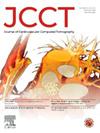CT-derived myocardial strain measurement in patients with chronic constrictive pericarditis
IF 5.5
2区 医学
Q1 CARDIAC & CARDIOVASCULAR SYSTEMS
引用次数: 0
Abstract
Background
We aimed to compare computed tomography (CT)-derived myocardial strain between patients with constrictive pericarditis (CP) and a matched healthy control group and to identify factors associated with clinical outcomes after pericardiectomy.
Methods
This retrospective study included 65 patients with CP (mean age: 58.9 ± 8.0 years) and 65 healthy individuals (mean age: 58.0 ± 6.5 years) who underwent multiphase cardiac CT. The type of CP was classified as calcified CP or fibrotic CP. CT-derived strains from four cardiac chambers were compared between the CP and control groups, as well as between different types of CP. Clinical and CT-derived factors associated with adverse outcomes were identified using Cox regression analysis.
Results
Compared with the control group, the CP group showed significantly lower values of left atrium (LA) reservoir strain (15.7 % vs. 27.4 %), right atrium (RA) reservoir strain (15.1 % vs. 27.0 %), left ventricle (LV) global longitudinal strain (GLS) (−17.0 % vs. −19.5 %), and right ventricle free wall longitudinal strain (−21.1 % vs. −25.9 %) (all p < 0.001). Biatrial reservoir strains and LV GLS were significantly lower in those with calcified CP compared to those with fibrotic CP. LA reservoir strain (hazard ratio, 0.91–95 % confidence interval, 0.86–0.96– p = 0.001) was an independent prognostic factor for adverse events in patients with CP.
Conclusion
Cardiac strain differences in CP were predominantly observed in the LA and RA compared to the healthy control group. Biatrial reservoir strains were specifically impaired in those with calcified CP than in those with fibrotic CP. LA reservoir strain was associated with prognosis in patients with CP following pericardiectomy.

慢性缩窄性心包炎患者的 CT 心肌应变测量。
背景:我们旨在比较缩窄性心包炎(CP)患者与匹配的健康对照组之间计算机断层扫描(CT)得出的心肌应变,并确定与心包切除术后临床结果相关的因素:这项回顾性研究纳入了 65 名接受多相心脏 CT 检查的 CP 患者(平均年龄:58.9 ± 8.0 岁)和 65 名健康人(平均年龄:58.0 ± 6.5 岁)。CP 的类型分为钙化 CP 和纤维化 CP。比较了 CP 组和对照组之间以及不同类型 CP 之间来自四个心腔的 CT 导出应变。通过 Cox 回归分析确定了与不良后果相关的临床和 CT 衍生因素:与对照组相比,CP 组的左心房(LA)贮液器应变(15.7 % vs. 27.4 %)、右心房(RA)贮液器应变(15.1 % vs. 27.0 %)、左心室(LV)整体纵向应变(GLS)(-17.0 % vs. -19.5%)和右心室游离壁纵向应变(-21.1 % vs. -25.9%)的值均显著降低(均为 p与健康对照组相比,CP 的心脏应变差异主要体现在 LA 和 RA。与纤维化心肌梗死患者相比,钙化心肌梗死患者的心房储层应变明显受损。心包切除术后,LA 储层应变与 CP 患者的预后有关。
本文章由计算机程序翻译,如有差异,请以英文原文为准。
求助全文
约1分钟内获得全文
求助全文
来源期刊

Journal of Cardiovascular Computed Tomography
CARDIAC & CARDIOVASCULAR SYSTEMS-RADIOLOGY, NUCLEAR MEDICINE & MEDICAL IMAGING
CiteScore
7.50
自引率
14.80%
发文量
212
审稿时长
40 days
期刊介绍:
The Journal of Cardiovascular Computed Tomography is a unique peer-review journal that integrates the entire international cardiovascular CT community including cardiologist and radiologists, from basic to clinical academic researchers, to private practitioners, engineers, allied professionals, industry, and trainees, all of whom are vital and interdependent members of our cardiovascular imaging community across the world. The goal of the journal is to advance the field of cardiovascular CT as the leading cardiovascular CT journal, attracting seminal work in the field with rapid and timely dissemination in electronic and print media.
 求助内容:
求助内容: 应助结果提醒方式:
应助结果提醒方式:


